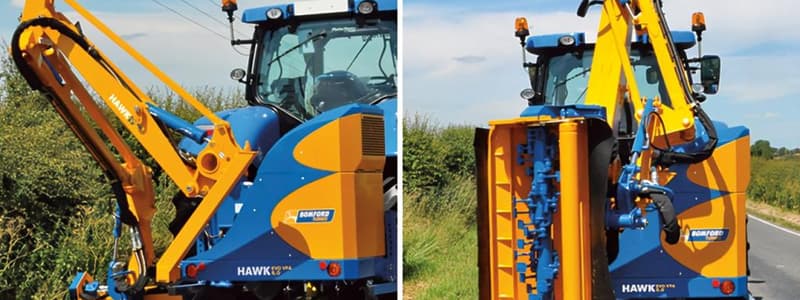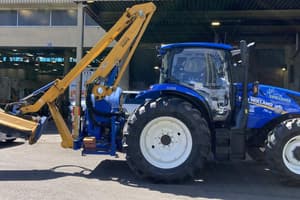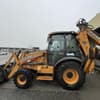Podcast
Questions and Answers
What is a hazard associated with flail mower operation?
What is a hazard associated with flail mower operation?
- Electric shock from the mower's electrical system
- Fire from the mower's engine
- Flying debris from the mower's blades (correct)
- Drowning from the mower's water tank
What must you keep in mind before climbing into the cab of the tractor?
What must you keep in mind before climbing into the cab of the tractor?
- Checking the mower's fuel level
- Maintaining three-point contact with the machine (correct)
- Listening to music while operating the mower
- Using a mobile phone while operating the mower
What is a crucial part of machine maintenance for a flail mower?
What is a crucial part of machine maintenance for a flail mower?
- Checking the mower's tire pressure
- Inspecting and maintaining the mower's blades and drivelines (correct)
- Replacing the mower's air filter
- Painting the mower's exterior
What should be included in operator training for a flail mower?
What should be included in operator training for a flail mower?
What is an environmental consideration when operating a flail mower?
What is an environmental consideration when operating a flail mower?
Why is it important to wear personal protective equipment (PPE) when operating a flail mower?
Why is it important to wear personal protective equipment (PPE) when operating a flail mower?
What is a common hazard associated with flail mower operation on sloping or uneven terrain?
What is a common hazard associated with flail mower operation on sloping or uneven terrain?
What should be done with waste and debris generated by flail mower operation?
What should be done with waste and debris generated by flail mower operation?
What is the primary purpose of ensuring only trained and qualified personnel use the flail mower?
What is the primary purpose of ensuring only trained and qualified personnel use the flail mower?
What is the purpose of machine guarding in flail mower operation?
What is the purpose of machine guarding in flail mower operation?
What is the risk associated with loose clothing while operating a flail mower?
What is the risk associated with loose clothing while operating a flail mower?
What is a key consideration in preventing PTO safety hazards?
What is a key consideration in preventing PTO safety hazards?
What is the primary purpose of assessing the residual risk rating?
What is the primary purpose of assessing the residual risk rating?
What is the relationship between the severity of an hazardous event and the risk rating?
What is the relationship between the severity of an hazardous event and the risk rating?
Why is it important to wear close-fitting clothing while operating a flail mower?
Why is it important to wear close-fitting clothing while operating a flail mower?
What should be done before handling the PTO?
What should be done before handling the PTO?
Who is most likely to be at risk from hedge cutter flail operations?
Who is most likely to be at risk from hedge cutter flail operations?
Why is it important to inspect the hedge before starting to cut?
Why is it important to inspect the hedge before starting to cut?
What type of injury is likely to occur in open spaces around Fences?
What type of injury is likely to occur in open spaces around Fences?
What should be in place when hedge-cutting near roads?
What should be in place when hedge-cutting near roads?
What is a hazard associated with rotating machine components?
What is a hazard associated with rotating machine components?
What areas are most likely to be affected by hedge cutter flail operations?
What areas are most likely to be affected by hedge cutter flail operations?
What is the severity of injury or damage likely to occur in areas with high risk ratings?
What is the severity of injury or damage likely to occur in areas with high risk ratings?
Why is it important to ensure the tractor engine is switched off when working with attachments?
Why is it important to ensure the tractor engine is switched off when working with attachments?
What dose of machine guards prevent ?
What dose of machine guards prevent ?
Who is responsible for ensuring public safety during hedge cutter flail operations?
Who is responsible for ensuring public safety during hedge cutter flail operations?
What is the likelihood of animal and third-party contractors being at risk from hedge cutter flail operations?
What is the likelihood of animal and third-party contractors being at risk from hedge cutter flail operations?
What type of injury or damage is most likely to occur in areas with low risk ratings?
What type of injury or damage is most likely to occur in areas with low risk ratings?
What is the primary reason for adjusting ballast and driving speed?
What is the primary reason for adjusting ballast and driving speed?
What should you consider when operating on inclines or steep hills?
What should you consider when operating on inclines or steep hills?
What is the warning 'Driving hazard' related to?
What is the warning 'Driving hazard' related to?
What is the consequence of operating the tractor in too high a gear under heavy load?
What is the consequence of operating the tractor in too high a gear under heavy load?
Why is it important to select the correct transmission ratio for each operation?
Why is it important to select the correct transmission ratio for each operation?
What should you avoid when operating the tractor?
What should you avoid when operating the tractor?
What is crucial for ensuring machine stability on inclines or steep hills?
What is crucial for ensuring machine stability on inclines or steep hills?
What is the recommended frequency for greasing all fittings?
What is the recommended frequency for greasing all fittings?
What can happen if the tractor is operated on a slope with an improper transmission ratio?
What can happen if the tractor is operated on a slope with an improper transmission ratio?
What is the primary focus of the 'Transmission' section?
What is the primary focus of the 'Transmission' section?
Where can you find information about the differential lock?
Where can you find information about the differential lock?
What is the consequence of not following machine stability requirements?
What is the consequence of not following machine stability requirements?
Why is it important to consider machine stability when operating on inclines or steep hills?
Why is it important to consider machine stability when operating on inclines or steep hills?
What is the primary concern related to machine stability?
What is the primary concern related to machine stability?
What is the purpose of emphasizing the 'Roll-over hazard' warning?
What is the purpose of emphasizing the 'Roll-over hazard' warning?
Why is it essential to consider the effect of inclines or steep hills on machine stability?
Why is it essential to consider the effect of inclines or steep hills on machine stability?
What should be checked every 10 hours or daily during tractor maintenance?
What should be checked every 10 hours or daily during tractor maintenance?
What is the purpose of the Wheel Angle Sensor (WAS) calibration?
What is the purpose of the Wheel Angle Sensor (WAS) calibration?
How often should the front wheel, rear wheel, and rear wheel weight nuts be checked?
How often should the front wheel, rear wheel, and rear wheel weight nuts be checked?
Why is it important to check the windscreen washer reservoir?
Why is it important to check the windscreen washer reservoir?
How often should all fittings be greased?
How often should all fittings be greased?
What is the purpose of checking the remote control valve drain bottles?
What is the purpose of checking the remote control valve drain bottles?
What is a critical aspect of machine stability on inclines?
What is a critical aspect of machine stability on inclines?
What is a key consideration in preventing rollover accidents?
What is a key consideration in preventing rollover accidents?
Flashcards are hidden until you start studying
Study Notes
Flail Mower Risk Assessment
Hazards Identification
- Moving parts: flail mower blades, PTO shaft, and drivelines
- Flying debris: rocks, wood chips, and other objects thrown by the mower
- Overturning: sloping or uneven terrain, loss of traction, and inadequate stability
- Entanglement: loose clothing, long hair, and jewelry getting caught in moving parts
- Noise: high decibel levels causing hearing damage
- Vibration: operator fatigue and discomfort
- Chemical exposure: herbicides, pesticides, and fertilizers
Operator Safety
- Wear personal protective equipment (PPE): hard hat, safety glasses, ear protection, gloves, and steel-toed boots
- Ensure proper seatbelt and ROPS (Rollover Protective Structure) usage
- Maintain three-point contact with the machine: two hands and one foot, or two feet and one hand
- Avoid operating in poor visibility, bad weather, or slippery surfaces
- Stay alert and focused; avoid distractions while operating the mower
Machine Maintenance
- Regularly inspect and maintain the mower, PTO shaft, and drivelines
- Check and replace worn or damaged blades
- Ensure proper tire pressure and traction
- Perform routine servicing: oil changes, filter replacements, and lubrication
- Keep the mower clean and free of debris to prevent fires
Operator Training
- Familiarize operators with the mower's operation, safety features, and emergency procedures
- Provide hands-on training and evaluation of operating skills
- Review and discuss safety protocols and emergency response plans
- Ensure operators understand the importance of regular machine maintenance and inspections
Environmental Impact
- Minimize soil compaction and erosion by avoiding wet or sensitive areas
- Avoid mowing in areas with endangered species or habitats
- Prevent chemical contamination of water sources and soil
- Dispose of waste and debris responsibly
- Consider using eco-friendly or organic alternatives to chemical herbicides and pesticides
Flail Mower Risk Assessment
Hazards Identification
- Flail mower blades, PTO shaft, and drivelines are moving parts that pose a risk
- Flying debris, including rocks, wood chips, and other objects, can be thrown by the mower
- Sloping or uneven terrain, loss of traction, and inadequate stability can cause overturning
- Loose clothing, long hair, and jewelry can get caught in moving parts, causing entanglement
- High decibel levels can cause hearing damage from noise
- Vibration can cause operator fatigue and discomfort
- Exposure to herbicides, pesticides, and fertilizers can be hazardous to health
Operator Safety
- Wear PPE: hard hat, safety glasses, ear protection, gloves, and steel-toed boots
- Ensure proper seatbelt and ROPS usage
- Maintain three-point contact with the machine: two hands and one foot, or two feet and one hand
- Avoid operating in poor visibility, bad weather, or slippery surfaces
- Stay alert and focused, avoiding distractions while operating the mower
Machine Maintenance
- Regularly inspect and maintain the mower, PTO shaft, and drivelines
- Check and replace worn or damaged blades
- Ensure proper tire pressure and traction
- Perform routine servicing: oil changes, filter replacements, and lubrication
- Keep the mower clean and free of debris to prevent fires
Operator Training
- Familiarize operators with the mower's operation, safety features, and emergency procedures
- Provide hands-on training and evaluation of operating skills
- Review and discuss safety protocols and emergency response plans
- Ensure operators understand the importance of regular machine maintenance and inspections
Environmental Impact
- Minimize soil compaction and erosion by avoiding wet or sensitive areas
- Avoid mowing in areas with endangered species or habitats
- Prevent chemical contamination of water sources and soil
- Dispose of waste and debris responsibly
- Consider using eco-friendly or organic alternatives to chemical herbicides and pesticides
Hazardous Events and Risks in Hedge Cutting Activities
- Hazardous event: Injury due to driver being hit by rotating components, resulting in entanglement, lacerations, dislocation of joints, and amputations.
- Existing control: Polycarbonate glazing and mesh windows to reduce the risk.
- Additional control: Only trained and qualified personnel should use the machines and attachments, and inspect the hedge before starting to cut and remove debris.
Entanglement Risks
- Hazardous event: Entanglement, lacerations, severe twisting of body parts, and amputations.
- Existing control: Undamaged guard in place and wear close-fitting clothing to prevent entanglement of loose clothing parts.
- Additional control: Instruct all operators about the hazards of the PTO (Power take off) and ensure it is fully stopped before handling.
Injury Risks from Cutting Heads
- Hazardous event: Injury being hit by cutting heads or flail, resulting in entanglement and drawing in.
- Existing control: Road warning signs should be in place, and any third parties kept away.
- Additional control: Instruct all operators about the hazards of cutting heads and ensure proper training.
Risk Rating Explanation
- Probability: Unlikely, Likely, Certain
- Severity: Minor injury or damage, Major injury or damage, Catastrophic injury or damage
- Risk Rating: Probability x Severity = Risk Rating
Front Wheel Bearings and Maintenance
- All fittings are greased during every 50 hours of maintenance.
- The front wheel bearings should be checked and greased every 50 hours.
Transmission and Shuttle Lever
- The section 'Transmission' deals with the shuttle lever.
- The shuttle lever is used to control the transmission of the tractor.
Differential Lock
- The information about the differential lock is found in Section 6, Working Operations.
- The differential lock is used to improve traction on uneven terrain.
Machine Stability
- Machine stability is crucial for safe operation.
- Inclines and steep hills can affect machine stability.
- Failure to follow machine stability requirements may result in machine rollover and death or serious injury.
Operating on Inclines or Steep Hills
- Operating on inclines or steep hills can affect machine stability and lead to accidents.
- The effect on machine stability should be considered when operating on inclines or steep hills.
Transmission Ratio
- The correct transmission ratio helps to save fuel and minimize engine wear.
- The transmission ratio should be selected based on the operation being performed.
Warning: Roll-over Hazard
- Machine instability can lead to accidents and injuries.
- The warning 'Roll-over hazard' is related to machine instability.
Adjusting Ballast and Driving Speed
- Adjusting ballast and driving speed is crucial to ensure stable and accurate steering.
- Stable and accurate steering is essential for safe operation.
Operating the Tractor
- Avoid overloading the engine, as it can cause harm to the engine.
- Operating the tractor in too high a gear under heavy load may cause excessive engine overloading.
Flail Mower Operation & Safety Training
- Regular checks are essential to ensure the tractor is running safely and efficiently.
- The engine coolant level should be checked every 10 hours or each day during tractor maintenance.
Wheel Angle Sensor (WAS) Calibration
- The purpose of the Wheel Angle Sensor (WAS) calibration is to calibrate the wheel alignment.
- Proper calibration ensures accurate wheel alignment and safe tractor operation.
Checking Wheel and Wheel Weight Nuts
- The front wheel, rear wheel, and rear wheel weight nuts should be checked every 50 hours.
- Regular checks of the wheel and wheel weight nuts are crucial for safety and to prevent accidents.
Checking Windscreen Washer Reservoir
- Ensuring the windscreen washer reservoir is full is crucial for safe driving.
- The windscreen washer reservoir should be checked to check the washer fluid level.
Greasing All Fittings
- Regular greasing of all fittings is essential to prevent corrosion and wear.
- All fittings should be greased every 50 hours.
Checking Remote Control Valve Drain Bottles
- Draining excess fluid from the remote control valve drain bottles is essential to prevent damage.
- The remote control valve drain bottles should be checked to drain excess fluid.
General Maintenance
- The remote control valve drain bottles should be checked and cleaned during general maintenance.
- Regular maintenance is essential to ensure the tractor is running safely and efficiently.
Studying That Suits You
Use AI to generate personalized quizzes and flashcards to suit your learning preferences.





